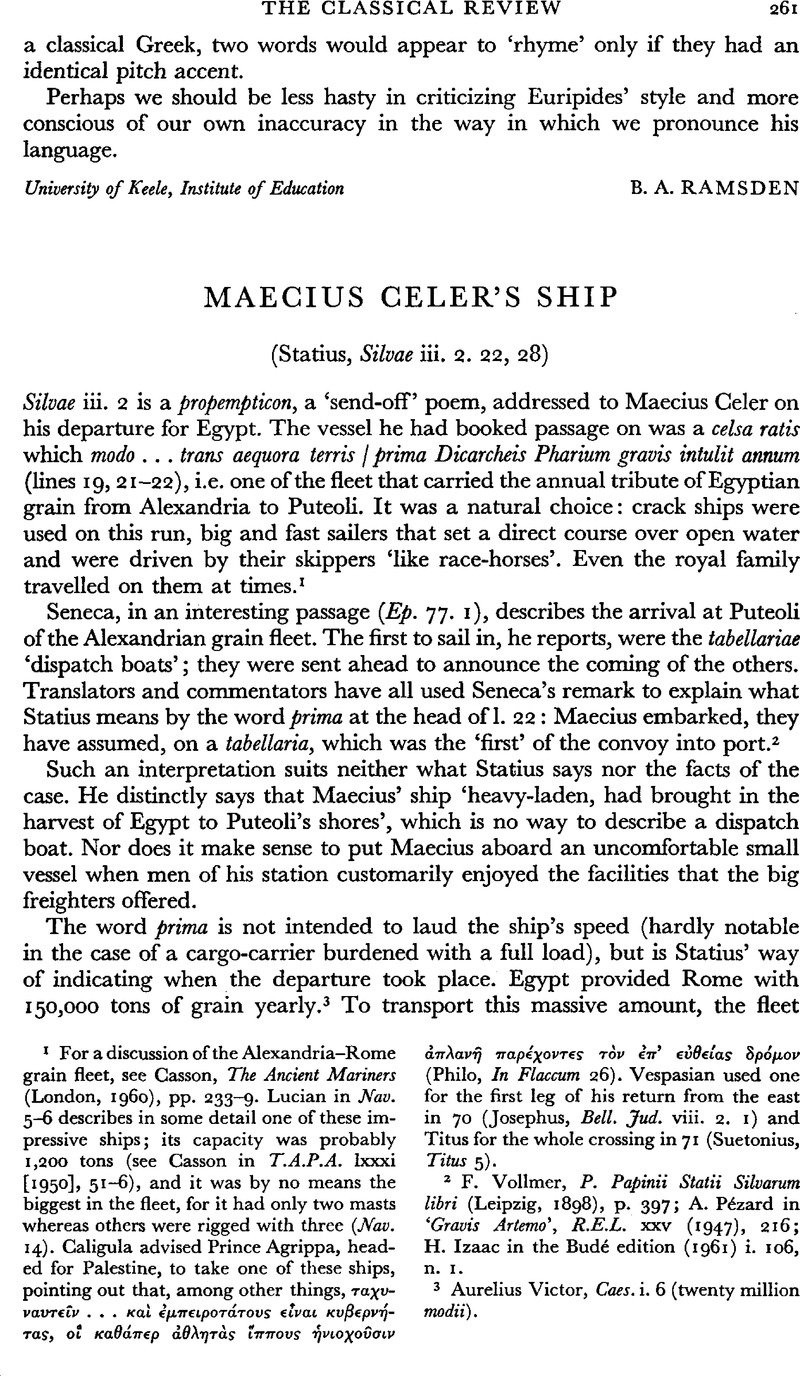No CrossRef data available.
Article contents
Maecius Celer's ship
Published online by Cambridge University Press: 27 February 2009
Abstract

- Type
- Review Article
- Information
- Copyright
- Copyright © The Classical Association 1968
References
page 261 note 1 For a discussion of the Alexandria–Rome grain fleet, see Casson, , The Ancient Mariners (London, 1960), pp. 233–239Google Scholar. Lucian in Nav. 5–6 describes in some detail one of these impressive ships; its capacity was probably 1,200 tons (see Casson, in T.A.P.A. lxxxi [1950], 51–56Google Scholar), and it was by no means the biggest in the fleet, for it had only two masts whereas others were rigged with three (Nav. 14). Caligula advised Prince Agrippa, headed for Palestine, to take one of these ships, pointing out that, among other things, ταχυναυτεῖν … κα⋯ ⋯μπειροτ⋯τους εἶναι κυβερν⋯-τας οἰ καθ⋯περ ⋯θλητ⋯ς ἵππους ⋯νιοχο⋯σιν ⋯πλαν⋯ παρ⋯χοντες τ⋯ν ⋯π' εὐθε⋯ας δρ⋯μον (Philo, In Flaccum 26). Vespasian used one for the first leg of his return from the east in 70 (Josephus, Bell. Jud. viii. 2. 1) and Titus for the whole crossing in 71 (Suetonius, Titus 5).
page 261 note 2 Vollmer, F., P. Papinii Statii Silvarum libri (Leipzig, 1898), p. 397Google Scholar; Pézard, A. in ‘Gravis Artemo’, R.E.L. xxv (1947), 216Google Scholar; H. Izaac in the Budé edition (1961) i. 106, n. 1.
page 261 note 3 Aurelius Victor, Caes. i. 6 (twenty million modii).
page 262 note 1 Vegetius iv. 39 gives 26 May to 14 September as the normal season, 10 March to 10 November as the outside limits. Cf. Cod. Theod. 13. 9. 3, which stipulates that government cargoes are to be transported between 13 April and 15 October.
page 262 note 2 Since the crossing had to be made in the teeth of the prevailing north-westerly winds, it could take two months or longer; see Casson, , T.A.P.A. lxxxi (1950), 43–51.Google Scholar
page 262 note 3 The evidence for these later crossings is supplied by those ships that failed to complete the voyage before the season closed, notably the freighter that St. Paul boarded at Myra (Acts 27: 6), which had only reached Crete (27: 9), and the one he completed his voyage on, which had got no further than Malta (28: 11).
page 262 note 4 B.G.U. 27 (= W. Chrest. 445 = Select Papyri 113; 2nd–3rd century A.D.) mentions arrival of the grain fleet on 30 June at Ostia (cf. Wilcken in Archiv ix [1930], 86). P. Mich. 490–1 (2nd century A.D.) mentions arrival at Ostia (by way of Cyrene) on 20 May, and P. Oxy. 2191 (2nd century A.D.) arrival at Puteoli on 29 May; the type of carrier is not mentioned, but both are evidence for early spring sailings out of Alexandria. An inscription, dated A.D. 79, from Puteoli (in Torrey, C., ‘The Exiled God of Sarepta’, Berytus ix [1948–1949], 47Google Scholar) records a ship that arrived at Puteoli from Tyre on 29 May—another example of an early spring sailing, since the journey is about the same length as that from Alexandria and has to be made against the same winds. Cicero, Ad Att. iv. 10. 1, written 22 April, mentions a rumour rife at Puteoli that Ptolemy Auletes had regained his throne; since it must have come by sea (overland news would have gone via Brindisi and the Appian Way), the ship that carried it clearly had been able to start very early in the year and made excellent time.
page 262 note 5 Note the word modo in line 21.
page 262 note 6 e.g. Virgil, Aen. iv. 573; Valerius Flaccus iii. 459.
page 262 note 7 Most think of the vessel as a galley: Vollmer (op. cit.); Izaac (op. cit.; he translates ‘que les unes replacent les bancs’); Slater (Oxford, 1908; he translates ‘let others arrange the thwarts’); Mozley in the Loeb edition (‘let others place the benches’); de Saint-Denis, E., Le vocabulaire des manæuvres nautiques en latin (Macon, 1935), pp. 100–101Google Scholar. Pézard, who realized it had to be a sailingship (and was aware that galley benches are solidly fixed), suggested (op. cit., p. 219) that the benches were for auxiliary rowers.
page 262 note 8 Big sailing-ships had themselves towed by the ship's boats (cf. Philostratus, Vita Ap. iv. 9); those small enough for auxiliary oars still had to use long sweeps whose loom described an arc so great that the oarsmen walked through the stroke.


